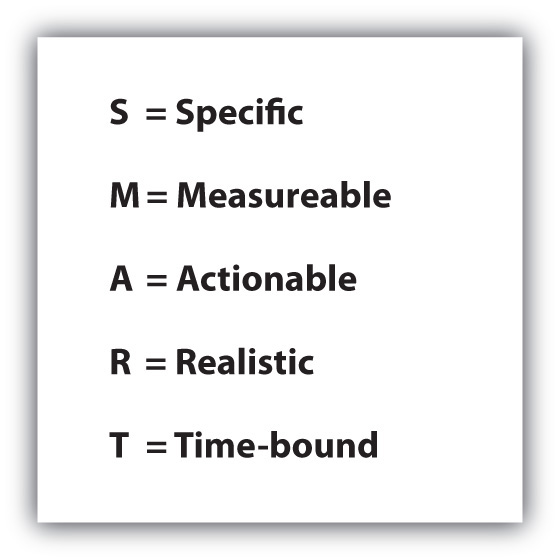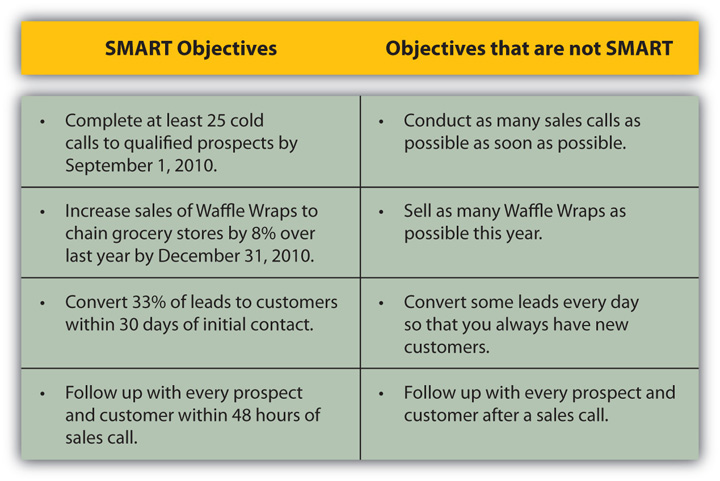This is “Identify Precall Objectives: Getting Smart about Your Sales Call”, section 8.3 from the book Powerful Selling (v. 1.0). For details on it (including licensing), click here.
For more information on the source of this book, or why it is available for free, please see the project's home page. You can browse or download additional books there. To download a .zip file containing this book to use offline, simply click here.
8.3 Identify Precall Objectives: Getting Smart about Your Sales Call
Learning Objective
- Learn how to set SMART precall objectives.
Identifying your prospect’s need is only part of your preapproach research. There’s still more research and planning for you to do before you meet with or speak to the customer.
Determine Your Objectives
If you haven’t determined what you hope to achieve before going into your sales call, it will be difficult to figure out what to say once you arrive or once you have your prospect on the phone. Setting precall objectivesGoals that are determined for the sales call before the call is made. is a strategically important step. If you have clear goals, you will be more confident and appear more organized, and it’s more likely that you will see results. Your customers are busy people, and you don’t want to waste their time. They will appreciate your organization and will be more likely to trust your judgment if you come prepared. You also don’t want to waste your time or your company’s time. According to Hoovers, the average sales call costs a company nearly $400!Gary Duncan, “Every Sales Call Requires an Objective and Decision,” Denver Business Journal, October 13, 2006, http://denver.bizjournals.com/denver/stories/2006/10/16/smallb8.html (accessed July 15, 2009).
As you plan your meeting, ask yourself this question: “What will success look like for this call?”American Institute of Public Certified Accountants, “Successful Selling Tips: The Sales Objective,” http://www.aicpa.org/Professional+Resources/CPA+Marketing+Toolkit/SellingTips6.htm (accessed July 15, 2009). That may seem like a question with a straightforward answer, but success doesn’t always mean closing the sale. In some situations, you’ll experience a one-call closeA sales call that results in a sale after one call., but with larger sales, particularly in B2B sales, the sales cycleThe length of time it takes to go from the first contact with the customer to closing the sale., or the length of time it takes to go from the first contact with the customer to closing the sale, is generally longer—sometimes even taking up to a year or longer. Consider Telegraph Hill Robes, a San Francisco-based company that sells bathrobes to upscale hotels with spas. Buying enough bathrobes to stock a hotel spa is a large investment, one that most customers have to carefully consider. The sale has to clear with two contacts at every company: the general manager and the head of housekeeping. As a result, when Telegraph Hill first started selling its product in 1996, its average sales cycle was two years!Susan Greco, “The Need for Speed,” Inc., April 2007, http://www.inc.com/magazine/20070401/salesmarketing-smart-selling.html (accessed July 15, 2009).
If you know that you are facing a longer sales cycle, the goal of your initial call might be gathering and conveying specific information to move forward in the sales process or further qualify your prospect. According to Gary Duncan, principal of the sales training organization Leadership Connections, “In more complex sales it’s realistic to set a precall objective of establishing rapport and trust, making new contacts in the organization, qualifying your prospect’s budget, or discovering what your prospect’s decision-making process is. For instance, you might decide you want to find out who your prospect’s current vendors are, any issues your prospect has with the services she is receiving, and what her goals are for future purchases.”Gary Duncan, “Every Sales Call Requires an Objective and Decision,” Denver Business Journal, October 13, 2006, http://denver.bizjournals.com/denver/stories/2006/10/16/smallb8.html (accessed July 15, 2009). You should also consider your prospect’s objectives: what outcome is she hoping for from this call?
Sometimes, setting strategic, information-gathering objectives may actually help you shorten your overall sales cycle. Take Acumen, a company that sells high-capability accounting software to corporations. Originally, the company’s sales cycle lasted around nine months. However, once the company became more strategic in its precall planning, designing a system of rigorous qualifying questions that its salespeople had to resolve before making a sales pitch, Acumen actually decreased its average sales cycle to somewhere between three and six months. Asking detailed questions during early sales calls allowed the company to cut back on the time it wasted brainstorming solutions and making sales pitches for underqualified leads.Susan Greco, “The Need for Speed,” Inc., April 2007, http://www.inc.com/magazine/20070401/salesmarketing-smart-selling.html (accessed July 15, 2009).
Make Your Objectives SMART
So it’s early in the process of a complex sale, and you are setting your goals for your next meeting with your customer. You know it will primarily be an information-gathering session because you need to know more before you can propose a workable, specific solution. However, if you go into the meeting with a vague plan like “I want to find out more about my prospect’s business,” you won’t accomplish much.Skills Connection, “How to Get Better Results from your Sales Meetings,” video, March 3, 2008, http://www.youtube.com/watch?v=1P6bU1efZbI (accessed July 15, 2009). Instead, you might come up with a goal similar to the one mentioned earlier: “By the end of this meeting, I want to know who my prospect’s current vendors are, what issues or challenges he faces with this vendor’s services, and what three priorities he has for future purchases.” This objective, like all effective precall objectives, is SMARTAn acronym to identify the elements of a successful sales goal: Specific, Measurable, Actionable, Realistic, and Time-bound.. That is, the goal is Specific, Measurable, Actionable, Realistic, and Time-bound.Virtual Strategist, “How to Set SMART Goals,” video, M3 Planning, October 17, 2008, http://www.youtube.com/watch?v=uThBb3kGf4k (accessed July 15, 2009).
- Specific. The goal should clearly define which actions you want your customer to take, what information you hope to convey, and/or what information you hope to learn from your sales call. In the example cited by Gary Duncan, the salesperson is setting out to gather three specific pieces of information.
- Measurable. You want to be able to measure the results of your efforts so that you’ll know at the end of your sales call how close you came to achieving what you set out to do. This will help you strategize about which actions to take next. The first two parts of the example are measurable with a simple yes or no (Did I find out the names of the current vendors? Did I identify issues and challenges my customer has encountered?), and the last part of the goal is quantifiable (How many of my customer’s priorities was I able to help him articulate?).
- Actionable. If a goal is actionable or attainable, it’s something you can actually do. It might involve asking questions, explaining something, or suggesting something. Whatever the case, it should be something on which you have the ability to act. In some instances, the actionable goal might be as simple as closing the sale: “By the end of the meeting, I plan to convince my prospect to sign a contract.”
- Realistic. If you set your goal too high or try to move your sales process along too quickly, you will only be setting yourself up for disappointment and failure. Ask yourself, “What can I reasonably hope to accomplish given the current situation with my prospect?” If you decide you want to get appointments with ten top people in the organization during your first contact with the company, or if you intend to close a major account by your first call, you will probably not be able to achieve what you set out to do.
- Time-bound. Not only should you know what you hope to achieve, but you should also know when you hope to have it accomplished. In the example objective, your time frame is “by the end of the sales call.” Other times, you might set a specific date—for example, “Get the prospect to agree to schedule a face-to-face meeting by the 15th.”
Figure 8.5 SMART Objectives

SMART objectives give you the power to sell strategically by setting goals you can achieve. Another powerful tool is the simple act of putting your goals down in writing. Not only are you likely to make a stronger commitment to your goals when you have them on paper, but you will also be able to use your written goals for reference later on—even during the sales call if you need to.Roy Chitwood, “Every Sales Call Must Have a Clear Objective,” Puget Sound Business Journal, September 26, 1997, http://www.bizjournals.com/seattle/stories/1997/09/29/smallb3.html?page=2 (accessed July 15, 2009).
Video Clip
Setting SMART Objectives
(click to see video)Watch this short video about setting SMART objectives for your sales calls.
Source: Skills Connection
Figure 8.6 Examples of SMART Objectives

Key Takeaways
- It’s important to know exactly what you want to accomplish when you go into a sales meeting.
- The goals for your sales call should be specific, measurable, actionable, realistic, and time-bound: SMART.
- Setting SMART goals will help you direct your approach, take action, and measure the results of your sales call.
Exercises
-
Which of the following is a SMART goal for your first sales call on a prospect to sell car insurance? Rewrite each of the other goals to be SMART.
- Identify current insurance carrier and conduct needs analysis by Friday.
- Call the customer and ask some questions to learn about his current situation.
- Conduct online research about the customer and understand why he chose his current insurance carrier.
- Call at least six new prospects by the end of the day today.
- Imagine you sell Web site consulting services and are going into a sales call with an existing customer. You want to expand the selling relationship in two ways: by extending your contract with the customer for another two years and by getting referrals for the network support department. Identify your SMART goal for this sales call.
- Assume you are a financial advisor and you are meeting with a prospect for the first time. Identify a SMART objective that you would set prior to your first meeting.
- Describe the difference in the sales cycles between selling jeans to a college student compared to selling a home to a newly married couple. What impact will that have on your SMART objectives?
- You are a sales rep for medical supplies and just took on a new prospect, Springfield Nursing Homes, a regional chain of twenty-two nursing homes. You have a contact, but you are not clear if he is a decision maker. In the past, the company has allowed each nursing home to make its own purchasing decisions, but it is moving toward a more centralized approach. This is an excellent opportunity for you to present your comprehensive product line. You are preparing for your first call, and your sales manager has asked you to review your SMART objectives for the call with him. What are your SMART objectives for the call? How you will present them to your sales manager?




